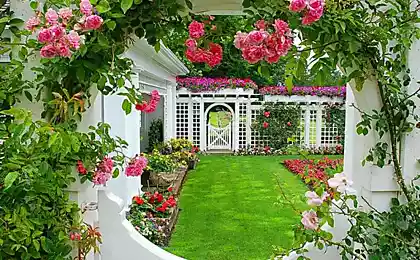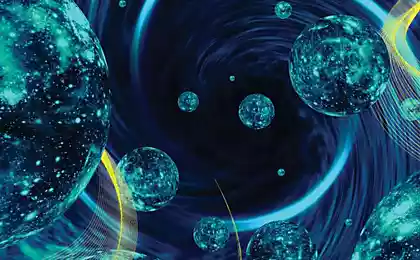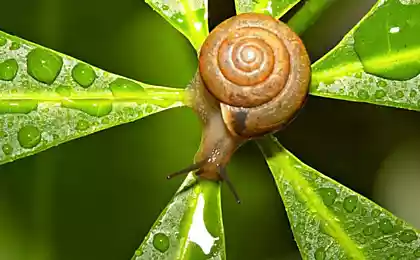265
War Myroff - harmful plant
May is the height of spring, and there is a lot of work in the garden, because the first fruits and berries will soon begin to appear, and you need to have time to complete protective measures to ensure yourself with high yields.
In general, there are many pests in the garden, but today I want to focus on several of them, these are ants and bark beetles. At present, neither the first nor the second, as a rule, is not given due attention. Often in the garden you can see large anthills, as well as trees eaten by beetles, and these insects are very dangerous!
These beings, as we know, are highly organized, this is a whole world with its own laws, orders, and features that have developed as a result of evolution, and not always the neighborhood with them is alarming for us.
Sometimes we may not notice an anthill growing somewhere in the corner of the garden for years, when suddenly one day flocks of ants will appear in the corner of the cottage, and plants will strangely begin to bend their young shoots.
On closer inspection, we will see hordes of aphids actively consuming the vital juices of young leaves, and ants scurrying up and down the shoots; so what is the connection?
It turns out that ants love everything sweet, and aphids are a kind of supplier of tasty padi, which she, defending herself, gives to ants. That is why they try to place these harmful insects in the most convenient places for them - young shoots with young leaves. Ants not only carry aphids from place to place, but also keep them in the winter in the anthill, trying to place insects on the roots of plants, sometimes digging long passages.
In this regard, ants clearly cause harm, but indirectly. The main damage is still caused by aphids, so, running ahead, I want to note that it is necessary to fight primarily with these insects. "Why?" you ask. Just because ants are good for us!
Ants eat caterpillars and larvae of various pests
Of course, they can arrange an anthill right in the middle of the bed with strawberries, making it difficult to collect, because they bite sometimes painfully; they acidify the soil and grow near the anthill can only be horsetail; they can safely eat the seeds that you sowed in the hope of harvesting a good harvest - this is all so.
However, there are advantages: this is the protection of our plants from caterpillars, naked slugs, larvae of flies and a whole armada of pests, this is the preservation and increase in some way the fertility of the soil, improving its structural composition, enrichment of the upper layers so necessary for plants with phosphorus and potassium. Perhaps some of these advantages still seem insignificant, and the decision will be made in favor of the destruction of the ant family.
The size of ant colony can reach from several hundred to more than a million individuals.
Ants graze aphids on plants and even protect it, eating its sweet secretions.
Our advice.
• The material of the fishing belt must be impregnated with any sticky or adhesive substance.
• Pests, getting into the fishing belt, which is a sticky labyrinth for them, linger in it for a very long time.
• You can only periodically check the fishing belts, and if you find a large accumulation of pests, burn them and install new ones. For this, many ways have been invented and tried, in addition to the destruction of aphids, which we have already mentioned, there are more aggressive ones, this is primarily the destruction of the anthills themselves. Of course, ecologists strongly advise to collect the anthill in a bucket and take out of the site, but so will the units. Most people water the anthill with boiling water, destroy them with subsequent deep digging, sprinkle soda, ash and quicklime, carbolka solution or simply flaxseed oil mixed with soda.
Catching belts can be made independently or bought in the garden center.
More peaceful gardeners simply place hunting belts on trees, they, by the way, will get rid of not only ants, but also other pests. The device of fishing belts is elementary, you can buy them in a specialized store, but you can do it yourself, the benefit of this is suitable for almost any available means. You can wrap the stamps with a bag, make a belt of glass wool, or apply rings of twine or harnesses from grass, perfectly suitable for the manufacture of a fishing belt tol and ruberoid, parchamine or ordinary paper.
Barrots feed on the living tissues and juices of the plant
Our reference
Bark beetles affect primarily trees weakened, sick, with wounds, burns or cracks in the bark. But it happens that attacks are made on young trees, the bark of which is very tender, during the period of abundant hydration.
Extreme measures are usually the use of toxic chemicals. By the way, it is not always possible to get the desired effect, so, the vast majority of poisons for ants are created on the basis of diazinone, this is the active substance, and the Ant familiar to many and the new drug Anteater, even the Thunder-2 actively advertised, is essentially the same diazinone.
Therefore, if after the use of one drug you did not get the expected effect, repeated treatments should also be carried out by them, there is no sense in changing the drugs. Remember that all drugs against ants can be destructive for most useful insects, as well as for bees and fish, so the use of toxic chemicals should be excluded near apiaries or stocked reservoirs!
But no matter how dangerous or not are ants, the most dangerous of this pair are bark beetles. First of all, these are familiar to us - wrinkled and apple, as well as unpaired bark beetle, they are found everywhere, and affect all fruit crops without exception. Beetles feed on the living tissues and juices of the plant, sometimes making long moves in which no less dangerous larvae live and winter.
Fighting bark beetles is sometimes very difficult, it is easier to carry out regular preventive measures. The very first of which is the attraction of birds to the garden, because it is no secret that in the forest, where there are many more, bark beetles are very few.
In addition, timely agrotechnical measures should be carried out, consisting in irrigation, plant feeding, removal of dry branches, smearing of wounds and cracks of the bark, freezer or burns. Young plants will help smear stamps with casein glue, this will prevent the laying of eggs by females under the bark. Whitewashing of stamps with water-based paint helps, and if these measures did not give results, then it is necessary to use poisonous chemicals.
Text: Nikolai Khromov, photo: Nikolai Khromov, TS/Fotobank.ru, photobank Lori
Source: www.ldacha.ru
In general, there are many pests in the garden, but today I want to focus on several of them, these are ants and bark beetles. At present, neither the first nor the second, as a rule, is not given due attention. Often in the garden you can see large anthills, as well as trees eaten by beetles, and these insects are very dangerous!
These beings, as we know, are highly organized, this is a whole world with its own laws, orders, and features that have developed as a result of evolution, and not always the neighborhood with them is alarming for us.
Sometimes we may not notice an anthill growing somewhere in the corner of the garden for years, when suddenly one day flocks of ants will appear in the corner of the cottage, and plants will strangely begin to bend their young shoots.
On closer inspection, we will see hordes of aphids actively consuming the vital juices of young leaves, and ants scurrying up and down the shoots; so what is the connection?
It turns out that ants love everything sweet, and aphids are a kind of supplier of tasty padi, which she, defending herself, gives to ants. That is why they try to place these harmful insects in the most convenient places for them - young shoots with young leaves. Ants not only carry aphids from place to place, but also keep them in the winter in the anthill, trying to place insects on the roots of plants, sometimes digging long passages.
In this regard, ants clearly cause harm, but indirectly. The main damage is still caused by aphids, so, running ahead, I want to note that it is necessary to fight primarily with these insects. "Why?" you ask. Just because ants are good for us!
Ants eat caterpillars and larvae of various pests
Of course, they can arrange an anthill right in the middle of the bed with strawberries, making it difficult to collect, because they bite sometimes painfully; they acidify the soil and grow near the anthill can only be horsetail; they can safely eat the seeds that you sowed in the hope of harvesting a good harvest - this is all so.
However, there are advantages: this is the protection of our plants from caterpillars, naked slugs, larvae of flies and a whole armada of pests, this is the preservation and increase in some way the fertility of the soil, improving its structural composition, enrichment of the upper layers so necessary for plants with phosphorus and potassium. Perhaps some of these advantages still seem insignificant, and the decision will be made in favor of the destruction of the ant family.
The size of ant colony can reach from several hundred to more than a million individuals.
Ants graze aphids on plants and even protect it, eating its sweet secretions.
Our advice.
• The material of the fishing belt must be impregnated with any sticky or adhesive substance.
• Pests, getting into the fishing belt, which is a sticky labyrinth for them, linger in it for a very long time.
• You can only periodically check the fishing belts, and if you find a large accumulation of pests, burn them and install new ones. For this, many ways have been invented and tried, in addition to the destruction of aphids, which we have already mentioned, there are more aggressive ones, this is primarily the destruction of the anthills themselves. Of course, ecologists strongly advise to collect the anthill in a bucket and take out of the site, but so will the units. Most people water the anthill with boiling water, destroy them with subsequent deep digging, sprinkle soda, ash and quicklime, carbolka solution or simply flaxseed oil mixed with soda.
Catching belts can be made independently or bought in the garden center.
More peaceful gardeners simply place hunting belts on trees, they, by the way, will get rid of not only ants, but also other pests. The device of fishing belts is elementary, you can buy them in a specialized store, but you can do it yourself, the benefit of this is suitable for almost any available means. You can wrap the stamps with a bag, make a belt of glass wool, or apply rings of twine or harnesses from grass, perfectly suitable for the manufacture of a fishing belt tol and ruberoid, parchamine or ordinary paper.
Barrots feed on the living tissues and juices of the plant
Our reference
Bark beetles affect primarily trees weakened, sick, with wounds, burns or cracks in the bark. But it happens that attacks are made on young trees, the bark of which is very tender, during the period of abundant hydration.
Extreme measures are usually the use of toxic chemicals. By the way, it is not always possible to get the desired effect, so, the vast majority of poisons for ants are created on the basis of diazinone, this is the active substance, and the Ant familiar to many and the new drug Anteater, even the Thunder-2 actively advertised, is essentially the same diazinone.
Therefore, if after the use of one drug you did not get the expected effect, repeated treatments should also be carried out by them, there is no sense in changing the drugs. Remember that all drugs against ants can be destructive for most useful insects, as well as for bees and fish, so the use of toxic chemicals should be excluded near apiaries or stocked reservoirs!
But no matter how dangerous or not are ants, the most dangerous of this pair are bark beetles. First of all, these are familiar to us - wrinkled and apple, as well as unpaired bark beetle, they are found everywhere, and affect all fruit crops without exception. Beetles feed on the living tissues and juices of the plant, sometimes making long moves in which no less dangerous larvae live and winter.
Fighting bark beetles is sometimes very difficult, it is easier to carry out regular preventive measures. The very first of which is the attraction of birds to the garden, because it is no secret that in the forest, where there are many more, bark beetles are very few.
In addition, timely agrotechnical measures should be carried out, consisting in irrigation, plant feeding, removal of dry branches, smearing of wounds and cracks of the bark, freezer or burns. Young plants will help smear stamps with casein glue, this will prevent the laying of eggs by females under the bark. Whitewashing of stamps with water-based paint helps, and if these measures did not give results, then it is necessary to use poisonous chemicals.
Text: Nikolai Khromov, photo: Nikolai Khromov, TS/Fotobank.ru, photobank Lori
Source: www.ldacha.ru























